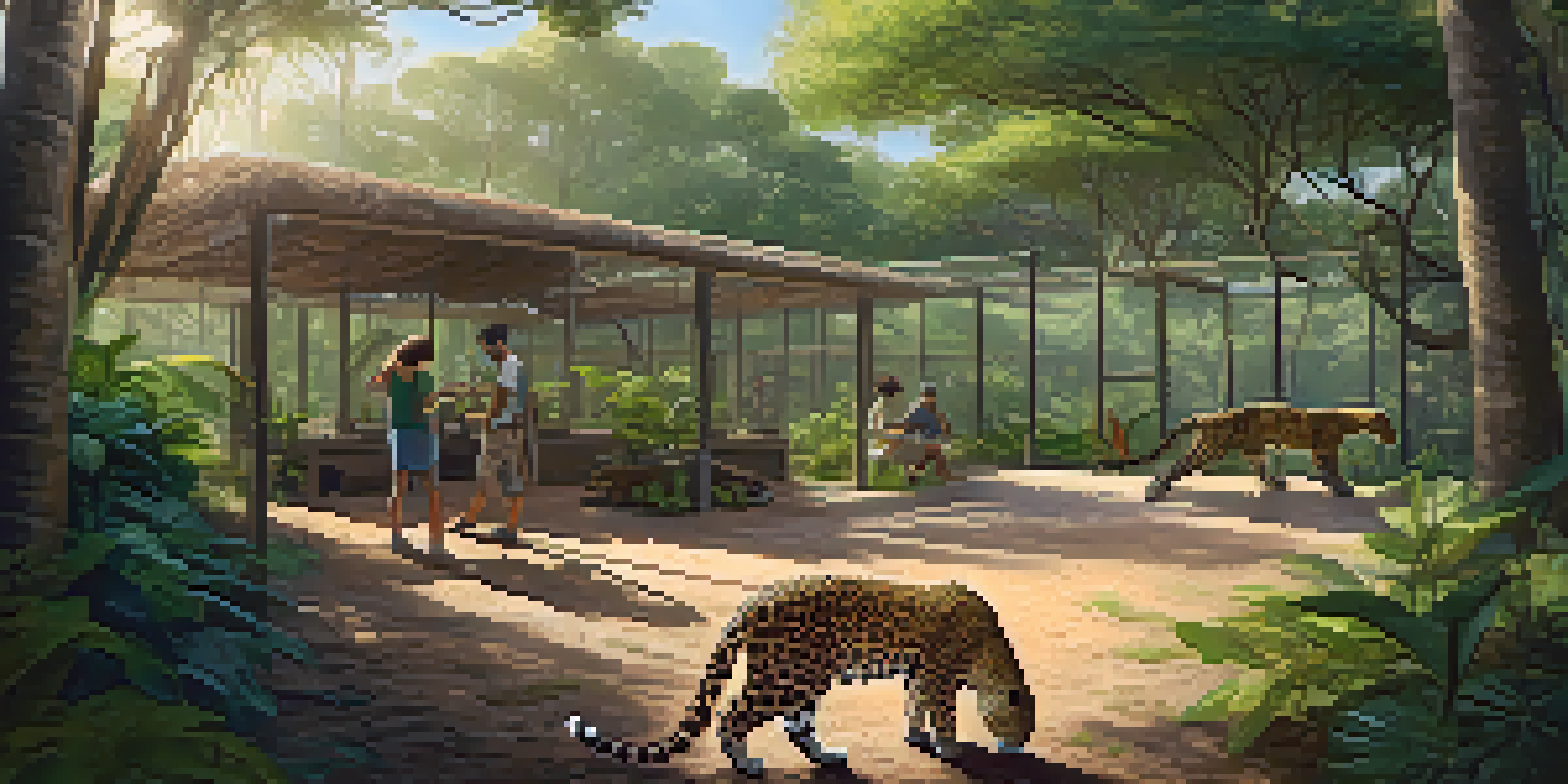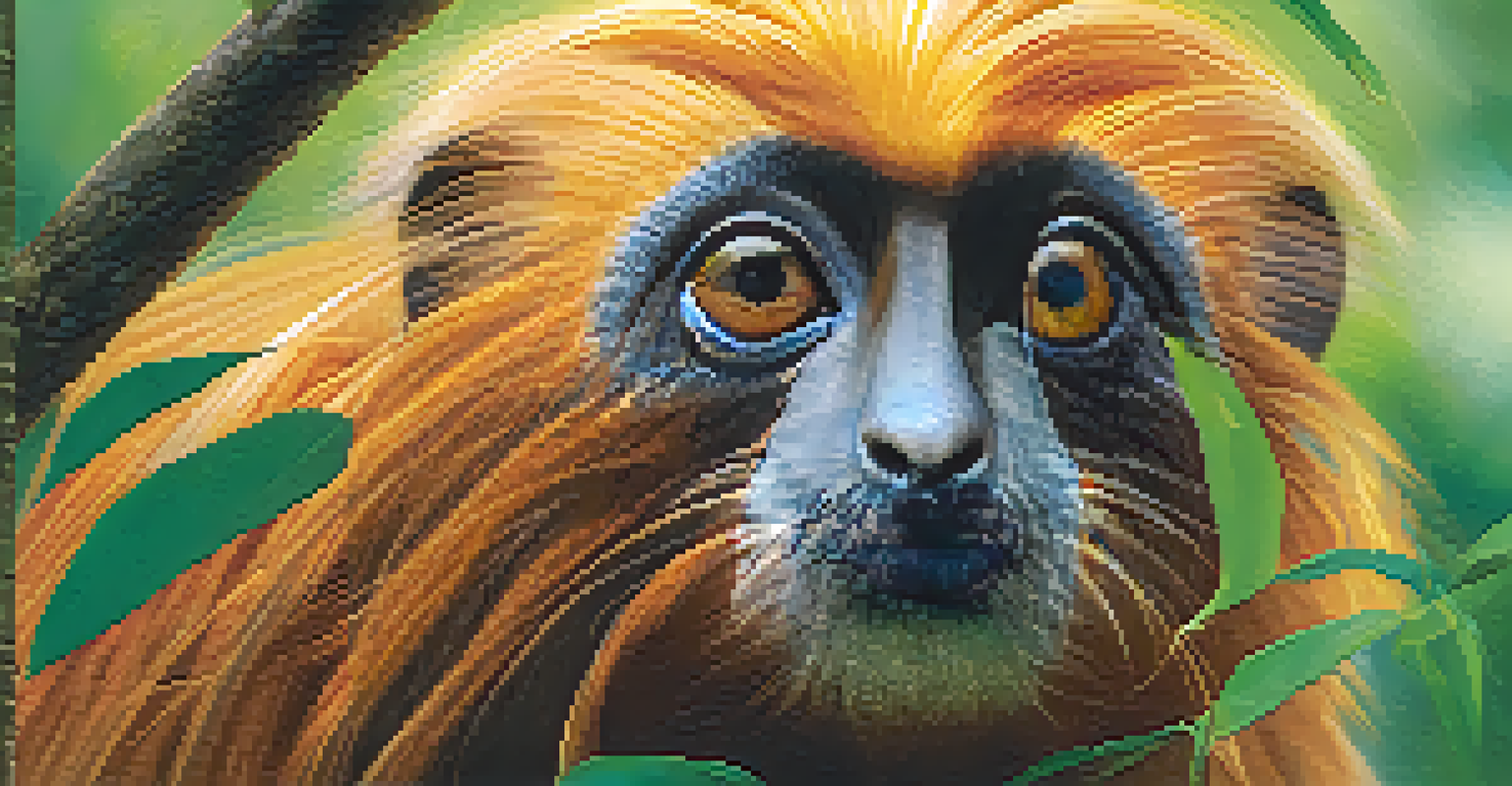Wildlife Rehabilitation: Supporting Brazil's Animal Rescue Efforts

Understanding Wildlife Rehabilitation in Brazil
Wildlife rehabilitation is a crucial process that aims to restore injured or orphaned animals back to their natural habitats. In Brazil, a country rich in biodiversity, this effort is particularly important due to the various threats faced by wildlife, including habitat loss and illegal trafficking. Rehabilitation centers play a vital role in providing medical care, nutrition, and shelter for these animals, helping them regain their strength and skills.
The greatness of a nation and its moral progress can be judged by the way its animals are treated.
These centers are staffed by dedicated professionals and volunteers who understand the unique needs of different species. For instance, a young jaguar might require special attention to learn hunting skills before being released into the wild, while a bird may need to regain its flight strength. The goal is always to prepare these animals for a successful return to their natural environment.
In addition to hands-on care, wildlife rehabilitation involves educating the public about the importance of conserving Brazil's unique ecosystems. By raising awareness, these centers foster a sense of responsibility and encourage community involvement, ultimately contributing to the preservation of wildlife.
Common Challenges Faced by Wildlife Rescuers
Wildlife rescuers in Brazil encounter numerous challenges that complicate their efforts. One major issue is the sheer volume of animals in need; many centers are overwhelmed, struggling to provide adequate care for all the creatures brought to them. This situation is exacerbated by the illegal wildlife trade, which often leads to an influx of injured or trafficked animals requiring urgent attention.

Additionally, funding for rehabilitation efforts can be inconsistent, making it difficult for centers to maintain operations and provide necessary resources. Many rely on donations and volunteer work, which can fluctuate and impact the level of care they can offer. For instance, a center may have to turn away animals simply due to a lack of resources, which is heartbreaking for both the rescuer and the animal.
Wildlife Rehabilitation's Vital Role
Wildlife rehabilitation in Brazil is essential for restoring injured or orphaned animals to their natural habitats amid threats like habitat loss and trafficking.
Moreover, the rehabilitation process itself can be long and complex. Each species requires a tailored approach, and the journey from rescue to release can take months or even years. Rescuers must navigate various obstacles, including legal regulations, species-specific needs, and environmental conditions, all while keeping the animals’ best interests at heart.
The Role of Local Communities in Animal Rescue
Local communities play a pivotal role in wildlife rehabilitation efforts across Brazil. Their involvement can range from reporting injured or orphaned animals to actively participating in rescue operations. Community awareness and education are essential in promoting conservation and ensuring that people understand how to coexist with local wildlife responsibly.
The future will be shaped by the choices we make today, not the choices we made yesterday.
For example, in some regions, local residents have established volunteer groups that work alongside rehabilitation centers to monitor wildlife and provide support during rescue missions. These grassroots initiatives not only help rescue animals but also strengthen community bonds and deepen appreciation for local biodiversity.
Moreover, when communities are engaged in wildlife conservation, they are more likely to support sustainable practices. This shift can lead to a decrease in habitat destruction and illegal poaching, creating a healthier environment for wildlife. By fostering a sense of ownership and responsibility towards their natural surroundings, communities become invaluable partners in the fight for wildlife preservation.
Success Stories That Inspire Change
Success stories from wildlife rehabilitation efforts in Brazil serve as powerful reminders of the impact of dedicated rescue work. For instance, the recovery of the golden lion tamarin, once on the brink of extinction, showcases how concerted rehabilitation and conservation efforts can yield positive results. Through habitat restoration and breeding programs, the population of this beautiful primate has significantly increased, illustrating the effectiveness of targeted efforts.
Another inspiring example is the rehabilitation and release of the maned wolf, which faced habitat loss due to agricultural expansion. After being nurtured back to health in a rescue center, these majestic creatures have been successfully reintroduced into their natural habitats, highlighting the importance of preserving ecosystems for wildlife to thrive.
Community Involvement is Key
Local communities play a crucial role in wildlife rescue by reporting injured animals and participating in conservation efforts, fostering a sense of responsibility.
These success stories not only motivate rescuers but also inspire the public to support wildlife rehabilitation initiatives. They remind us that every effort counts and that restoring balance in nature is achievable with dedication and community involvement.
The Importance of Education in Wildlife Conservation
Education is a cornerstone of wildlife rehabilitation and conservation efforts in Brazil. By informing the public about the challenges facing wildlife, rehabilitation centers can foster a culture of respect and care for animals. Workshops, school programs, and community events are some of the ways these centers engage with people, making conservation a shared responsibility.
For example, educational programs often include interactive activities that allow participants to connect with local wildlife, helping them understand the ecological roles these species play. When people see the animals up close, it can ignite a passion for conservation that translates into action, such as reporting illegal activities or participating in local clean-up efforts.
Additionally, educating the next generation is vital for the future of wildlife conservation. By instilling values of empathy and stewardship in children, we can cultivate a new generation of advocates who will continue the fight for wildlife long after current efforts have been made. The ripple effect of education can be profound, impacting not just wildlife but entire ecosystems and communities.
How Technology Supports Wildlife Rehabilitation
In the age of technology, wildlife rehabilitation in Brazil is benefiting from innovative tools and techniques. Drones, for instance, are increasingly used to monitor habitats and track animal movements, providing invaluable data that can enhance rehabilitation and conservation strategies. This technology allows rescuers to assess the health of ecosystems more efficiently and effectively.
Moreover, social media plays a significant role in raising awareness about wildlife issues. Rehabilitation centers can share stories, updates, and educational content with a global audience, garnering support and donations from people who are passionate about animal welfare. This digital outreach helps create a community of advocates, all working together for wildlife.
Education Drives Conservation Success
Educational initiatives are fundamental in promoting wildlife conservation, helping to instill values of empathy and stewardship in future generations.
Additionally, advancements in veterinary medicine and animal care technology are improving rehabilitation outcomes. From better diagnostic tools to more effective treatments, these innovations enable rescuers to provide higher-quality care, increasing the chances of successful rehabilitation and release back into the wild.
Supporting Brazil's Wildlife: How You Can Help
Supporting wildlife rehabilitation efforts in Brazil can take many forms, and every little bit helps. One of the most direct ways to contribute is through donations to local rehabilitation centers, which often rely on these funds to provide care for animals in need. Even small contributions can make a significant difference, helping cover food, medical supplies, and operational costs.
Volunteering your time is another impactful way to support these efforts. Many rehabilitation centers welcome volunteers to assist with various tasks, from caring for animals to helping with community outreach programs. By getting involved, you not only contribute to a worthy cause but also gain firsthand experience and knowledge about wildlife conservation.

Lastly, spreading awareness about wildlife issues can create a ripple effect that encourages others to take action. Whether through social media, community events, or casual conversations, sharing information about the importance of wildlife rehabilitation can inspire a collective effort toward protecting Brazil's rich biodiversity for future generations.